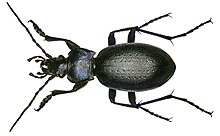
Animal husbandry is the branch of agriculture concerned with animals that are raised for meat, fibre, milk, or other products. It includes day-to-day care, selective breeding, and the raising of livestock. Husbandry has a long history, starting with the Neolithic Revolution when animals were first domesticated, from around 13,000 BC onwards, predating farming of the first crops. By the time of early civilisations such as ancient Egypt, cattle, sheep, goats, and pigs were being raised on farms.

Pasture is land used for grazing. Pasture lands in the narrow sense are enclosed tracts of farmland, grazed by domesticated livestock, such as horses, cattle, sheep, or swine. The vegetation of tended pasture, forage, consists mainly of grasses, with an interspersion of legumes and other forbs. Pasture is typically grazed throughout the summer, in contrast to meadow which is ungrazed or used for grazing only after being mown to make hay for animal fodder. Pasture in a wider sense additionally includes rangelands, other unenclosed pastoral systems, and land types used by wild animals for grazing or browsing.

In agriculture, grazing is a method of animal husbandry whereby domestic livestock are allowed outdoors to roam around and consume wild vegetations in order to convert the otherwise indigestible cellulose within grass and other forages into meat, milk, wool and other animal products, often on land unsuitable for arable farming.

Phalaris is a genus of grasses. Various species of Phalaris grow on every continent except Antarctica. They can be found in a broad range of habitats from below sea level to thousands of feet above sea level and from wet marshy areas to dry places. P. arundinacea and P. aquatica are sometimes invasive species in wetlands.
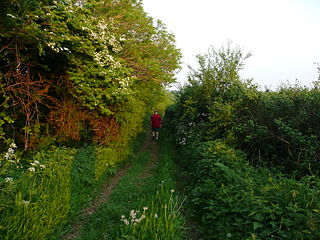
A drovers' road, drove [road] or droveway is a route for droving livestock on foot from one place to another, such as to market or between summer and winter pasture. Many drovers' roads were ancient routes of unknown age; others are known to date back to medieval or more recent times.

Crofting is a form of land tenure and small-scale food production particular to the Scottish Highlands, the islands of Scotland, and formerly on the Isle of Man. Within the 19th-century townships, individual crofts were established on the better land, and a large area of poorer-quality hill ground was shared by all the crofters of the township for grazing of their livestock.

Pastoral farming is aimed at producing livestock, rather than growing crops. Examples include dairy farming, raising beef cattle, and raising sheep for wool. In contrast, arable farming concentrates on crops rather than livestock. Finally, mixed farming incorporates livestock and crops on a single farm. Some mixed farmers grow crops purely as fodder for their livestock; some crop farmers grow fodder and sell it. In some cases pastoral farmers are known as graziers, and in some cases pastoralists. Pastoral farming is a non-nomadic form of pastoralism in which the livestock farmer has some form of ownership of the land used, giving the farmer more economic incentive to improve the land. Unlike other pastoral systems, pastoral farmers are sedentary and do not change locations in search of fresh resources. Rather, pastoral farmers adjust their pastures to fit the needs of their animals. Improvements include drainage, stock tanks, irrigation and sowing clover.
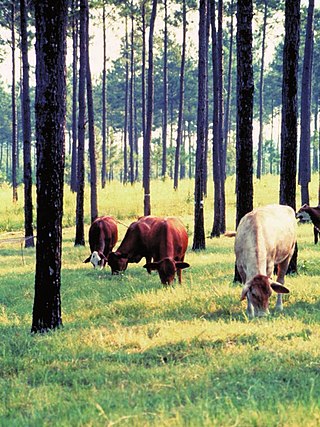
Silvopasture is the practice of integrating trees, forage, and the grazing of domesticated animals in a mutually beneficial way. It utilizes the principles of managed grazing, and it is one of several distinct forms of agroforestry.

Milk sickness, also known as tremetol vomiting or, in animals, as trembles, is a kind of poisoning, characterized by trembling, vomiting, and severe intestinal pain, that affects individuals who ingest milk, other dairy products, or meat from a cow that has fed on white snakeroot plant, which contains the poison tremetol.
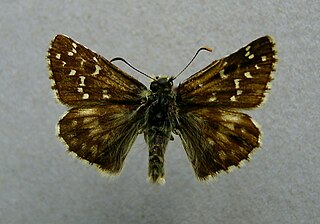
The Large Grizzled skipper is a species of skipper butterfly.

Conservation grazing or targeted grazing is the use of semi-feral or domesticated grazing livestock to maintain and increase the biodiversity of natural or semi-natural grasslands, heathlands, wood pasture, wetlands and many other habitats. Conservation grazing is generally less intensive than practices such as prescribed burning, but still needs to be managed to ensure that overgrazing does not occur. The practice has proven to be beneficial in moderation in restoring and maintaining grassland and heathland ecosystems. The optimal level of grazing will depend on the goal of conservation, and different levels of grazing, alongside other conservation practices, can be used to induce the desired results.

Hill farming or terrace farming is an extensive farming in upland areas, primarily rearing sheep, although historically cattle were often reared extensively in upland areas. Fell farming is the farming of fells, a fell being an area of uncultivated high ground used as common grazing. It is a term commonly used in Northern England, especially in the Lake District and the Pennine Dales. Elsewhere, the terms hill farming or pastoral farming are more commonly used.

The Magharee Islands, also known as "The Seven Hogs", are a group of uninhabited islands located off Rough Point at the northern tip of the Magharee Peninsula in County Kerry, Ireland. The islands, which are part of the parish of Castlegregory, are well known as excellent diving and snorkelling destinations.

Carabus nitens is a species of ground beetle native to the Palearctic. In Europe, it is observed in Austria, the Baltic states, Benelux, the Czech Republic, France, Germany, Great Britain including the Isle of Man, Republic of Ireland, Kaliningrad, Northern Ireland, Poland, Romania, Scandinavia, Slovakia, and Eastern Europe.
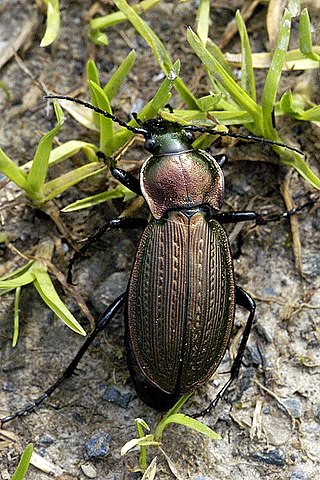
Carabus monilis, the necklace ground beetle, is a species of beetle endemic to Europe, where it is observed in Austria, Belgium, mainland France, Germany, Great Britain including the Isle of Man, the Republic of Ireland, mainland Italy, Liechtenstein, Luxembourg, mainland Norway, mainland Spain, Switzerland, and the Netherlands.

Carabus catenulatus is a species of beetle endemic to Europe, where it is observed in Bosnia and Herzegovina, mainland Italy, Croatia, Slovenia, and Switzerland.

Carabus caelatus is a species of beetle endemic to Europe, where it is observed in Albania, Austria (doubtful), mainland Italy, and all states of former Yugoslavia.

Carabus gigas is a species of beetles of the family Carabidae.

Carabus splendens is a species of beetle endemic to Europe, where it is observed in mainland France and mainland Spain.
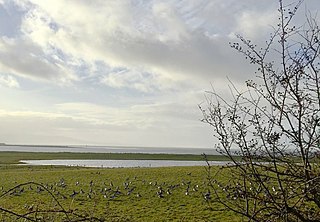
Ballygilgan also known as The Goose Field is a national nature reserve of approximately 73 acres (0.30 km2) on the Maugherow Peninsula in County Sligo, Ireland. It is home to Ireland’s biggest mainland flock of barnacle geese. It is managed by the Irish National Parks & Wildlife Service.
